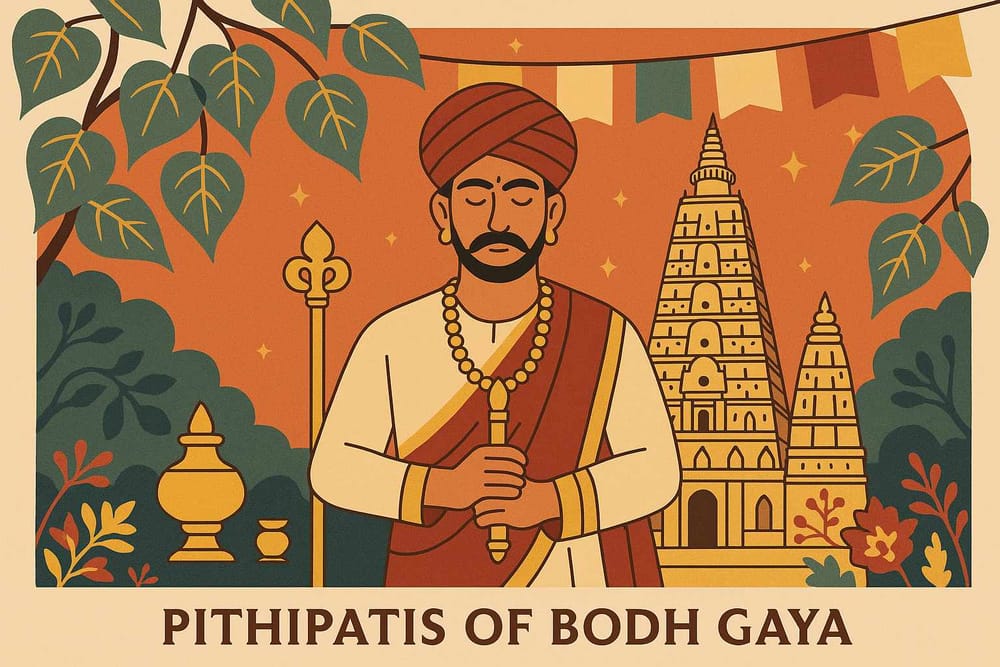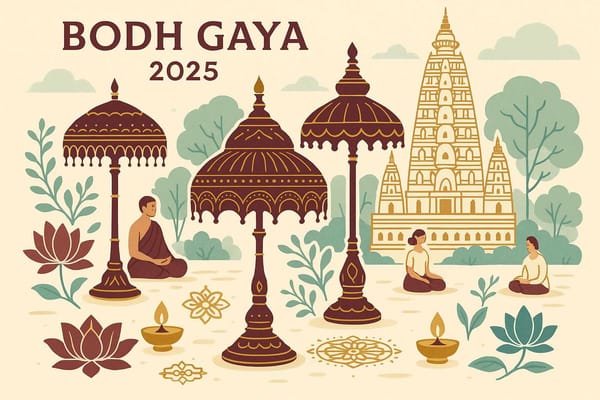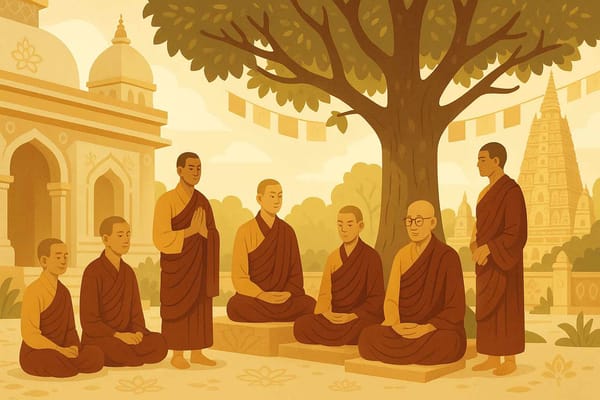
Pithipatis of Bodh Gaya: Guardians and Legacy Explored
Have you ever stood in a place so drenched in history that you could almost feel the echoes of the past? Bodh Gaya is one such place. Just standing near the sacred Bodhi tree, you can feel a deep sense of peace, a connection to something ancient and profound. It’s here that Prince Siddhartha became the Buddha. But have you ever wondered who kept the flame of this sacred place alive through centuries of change, invasions, and the simple passage of time? The answer lies in the story of the Pithipatis, the traditional guardians of Bodh Gaya, whose legacy is as deep and complex as the roots of the tree they protected.
Who Were the Pithipatis? Unraveling a Sacred Lineage
The name "Pithipati" itself tells a story. It comes from the Sanskrit words 'pitha', meaning the sacred seat (referring to the Vajrasana or Diamond Throne where Buddha attained enlightenment), and 'pati', meaning lord or protector. They were not just caretakers; they were the rulers of the Magadha region (modern-day Bihar) from the 11th to the 13th centuries. It’s believed that their journey began as religious authorities, deeply respected priests whose wisdom and dedication eventually grew into political influence.
Many wonder about the history of the Pithipatis, and their story is woven into the very fabric of Bodh Gaya. Inscriptions found within the Mahabodhi Temple complex tell tales of their dedication, documenting royal grants and the formalisation of their duties. Theirs was a hereditary tradition, a sacred responsibility passed down from one generation to the next, ensuring that the sanctity of this holy site was never compromised. They were the bridge between the spiritual and the temporal worlds, the silent sentinels watching over the heart of Buddhism.
More Than Just Caretakers: The Sacred Duties of the Pithipatis
To think of the Pithipatis as mere administrators would be to miss the soul of their purpose. Their responsibilities were vast and deeply spiritual, forming the bedrock of Bodh Gaya’s cultural ecosystem.
- Guardians of Sacred Rituals: The Pithipatis were the heart of the temple's spiritual life. They weren’t just overseeing rituals; they were ensuring that every chant, every offering, and every ceremony was performed with the utmost devotion, exactly as it had been for centuries. This dedication to tradition is a powerful reminder of how storytelling and art sustain our spiritual practices, a concept we explore further in preserving legacies through art.
- Protectors of the Bodhi Tree: Their most sacred duty was the preservation of the Bodhi tree. This wasn't just a tree; it was and is a living symbol of enlightenment. They protected it with a fierce devotion, understanding that its well-being was directly tied to the spiritual health of Bodh Gaya itself.
- Ambassadors of Dharma: During their time, Bodh Gaya was a global hub for Buddhist pilgrims and scholars. The Pithipatis acted as hosts and mediators, fostering a vibrant exchange of culture and knowledge with visitors from places as far as Sri Lanka. Inscriptions detail their generosity, such as granting land to Sri Lankan monks, strengthening the bonds of the global Buddhist community.
- Keepers of Ancient Wisdom: They were also the protectors of invaluable ancient manuscripts and sacred relics connected to the Buddha’s life. By safeguarding this knowledge, they ensured that the legacy of Bodh Gaya would not just survive, but thrive for future generations to learn from and cherish.
The Pithipati Legacy in Today's World: A Complex Picture
The role of a guardian is never static; it must evolve with time. While the direct rule of the Pithipatis ended centuries ago, their legacy continues to shape Bodh Gaya. However, the modern era has brought new challenges and complexities. After the Mahabodhi Temple Complex was named a UNESCO World Heritage site in 2002, the world’s attention turned to this sacred space, bringing with it the challenge of balancing international tourism with spiritual sanctity.
Today, the management of the temple is a topic of heartfelt discussion. The Bodh Gaya Temple Act of 1949 established a management committee of both Hindus and Buddhists. For many years, this has been the way, but recently, a deep yearning has emerged within the Buddhist community. As of 2025, there have been long-standing, peaceful protests by Buddhist monks who feel that the management of their most sacred site should be exclusively in the hands of the Buddhist community. They have been holding sit-in protests for months, seeking a change to the 76-year-old law.
This situation shows how the role of a "guardian" has evolved. From a hereditary lineage of Pithipatis to a government-appointed committee, the question of who protects this sacred legacy remains as important as ever. It highlights the ongoing dialogue between tradition, community identity, and modern governance. The Pithipatis' contribution is undeniable; they ensured that Bodh Gaya remained a beacon of Buddhist heritage, and now, a new chapter in its guardianship is being written.
This incredible tale of devotion and preservation reminds us of the power of faith, much like the spiritual legacy of Udaipur, where history and divinity are intertwined. These stories of guardianship are vital because they teach us the importance of holding onto our roots.
From Ancient Scrolls to Digital Screens with Bhaktilipi
Just as the Pithipatis carefully preserved ancient manuscripts and sacred traditions, we at Bhaktilipi are dedicated to a similar cause in the digital age. Our mission is to be a trusted space where timeless devotional stories, sacred texts, and spiritual wisdom are shared in a way that connects with you today, while honouring the profound traditions they come from.
At Bhaktilipi.in, we offer carefully curated and translated content to help you explore the richness of our spiritual heritage. Whether you are looking for inspiring stories like that of the Pithipatis, ancient scriptures, or articles that deepen your connection to tradition, our platform is here to support your spiritual journey.
Stay Connected with Our Community
Join our growing family and continue your journey of Bhakti & beyond. Subscribe to our newsletter for regular updates and follow us on social media for a daily dose of inspiration!
Honoring a Legacy That Lives On
The Pithipatis of Bodh Gaya carry a profound legacy rooted in devotion, duty, and preservation. Their story is a powerful reminder that the world’s most sacred places are kept alive not just by bricks and mortar, but by the unwavering faith of their guardians. In our fast-changing world, they teach us the importance of staying connected to our heritage and the spiritual values that shape our identity.
As we learn about their contributions, we don't just honour their memory; we deepen our own appreciation for the timeless wisdom they safeguarded. The Pithipatis were not just guardians of a temple—they were guardians of a way of life. Let us continue to respect and support the torchbearers of tradition, ensuring their legacy remains vibrant for generations to come.
A passionate group of people dedicated to preserving India's knowledge of Dharma, Karma, and Bhakti for ourselves and the world 🙏.
Comments
Related in

Pithipatis of Bodh Gaya-Guardians of Spiritual Heritage: An Exploration
There are places on Earth where the air itself feels different, heavy with history and alive with devotion. Bodh Gaya is one such sacred ground. It’s a place where millions come seeking peace, tracing the footsteps of Gautama Buddha to the very spot under the Bodhi Tree where he

Exploring the Mystical Pithipatis of Bodh Gaya: A 2025 Guide
There's a certain magic in the air of Bodh Gaya. You feel it the moment you arrive. It’s not just in the majestic silhouette of the Mahabodhi Temple against the sky, or the gentle rustling of leaves on the sacred Bodhi Tree. It’s a deep, humming

Unveiling the Mysteries of the Pithipatis of Bodh Gaya- 2025 Insights
Have you ever walked through a place so thick with history that you could almost feel the echoes of the past? Bodh Gaya is one such place. As you stand near the magnificent Mahabodhi Temple, under the shade of a descendant of the sacred Bodhi Tree, you can feel a
